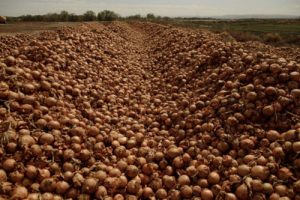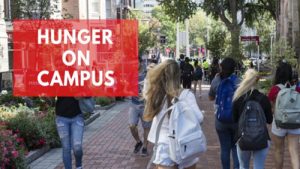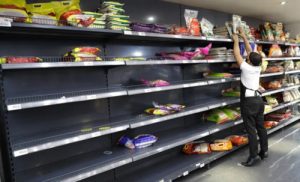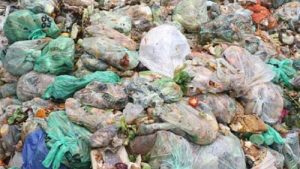Left in Limbo: College Food Insecurity, Job Losses and Waste Rise Amid COVID-19. Can our Food System Handle It?
Picture this: You’re a college student working a few part-time jobs and going to school full time. You barely make enough money to cover tuition expenses, groceries, gas money, and textbooks. You are living paycheck to paycheck. You hear about a virus spreading in China, but you aren’t that concerned and are preoccupied with your own day-to-day worries. Then March, 2020 comes around. You are kicked off your campus, scrambling to go home as your classes transition to an online format. Those part-time jobs you had? Gone. Apparently, you’re not an essential worker. Your parents don’t have the extra income to help support you any longer; they have the rest of your family to support. Oh, and your on-campus housing and meal plan aren’t being prorated, so you have to apply for unemployment and SNAP to afford groceries. You’re an adult after all, you should be able to take care of yourself on your own…right?
The federal assistance program for SNAP requires students who attend college half-time to work at least 20 hours per week to qualify. But as the pandemic is causing unemployment to reach record highs many college students are being left ineligible, which means many students will go hungry. Though state officials fought to change the requirements, the US Department of Agriculture’s Food and Nutrition agency denied the states’ requests.
Even before COVID-19, student eligibility for SNAP was complicated, nebulous, and excluded many (Amour, 2020). It is very likely that those who do receive current assistance will soon be unable to meet the work requirements, leaving them food insecure. COVID-19 is making it very difficult for students to earn a living wage, to access food for themselves and their families.
Looking at the issues arising given COVID-19 conditions, perhaps the country can learn something about our economy, our nation and culture, and how fragile industries like agriculture truly are. There’s so much work that goes on behind the scenes for every meal: the farmers that grow your food, the field laborers who harvest the crops, the warehouse workers who ready it, and the truck drivers who bring it to stores and the workers inside for distribution to your store shelves. More and more people are appreciating the value of food as it becomes scarce, and access more difficult. Yet COVID-19 is burdening our food system at every step. As a nation, we are struggling — as farmers, field laborers, workers and consumers.
Domestic Food Waste Increasing
With the COVID-19 pandemic, to say that food waste is on the rise would be a drastic understatement. Under normal circumstances, the United States wastes 40 percent of its food annually, amounting to 70 billion tons each year. With people hoarding and nervously buying food to stock their household, food waste is at a high, as families are often unable to eat it all before it goes to waste (Royte, 2020). While shoppers are panic buying more food than they can eat and increasing its waste, others are unable to afford groceries at all, given reduced wages and layoffs. In addition, many grocery stores that donate unsold food to nonprofits to aid the food insecure have none to give as a result of panic buying and hoarding. (Bryan, 2020). The pandemic and consumers have created a vicious cycle of waste and need.
Undocumented Workers are Essential Workers
All the while, in the fields, agricultural workers have continued to ensure the stability of the supply chain despite hazardous conditions. Farm workers fear for their lives given a lack of protective equipment and spacing to prevent the spread of the virus. They have no gloves, no masks, and work in close quarters with one another. Who wouldn’t be scared? Most workers, many undocumented, have no health insurance and are living on $500 or less a month. It also doesn’t help that the current political climate is hostile towards immigrants who make up the majority of this labor force. How this will affect the ability of food to be harvested for grocery stores is still uncertain. What is known is that farm workers are a critical labor force in times of pandemic uncertainty. Someone needs to harvest the food and get it ready for sale to keep the nation fed (Flores, A., 2020).
Farmers Forced to Dump Perfectly Good Food, Food Waste Skyrockets

A field of onions waiting to be buried in Nyssa, Idaho on April 10, 2020. (Joseph Haeberle / The New York Times)
Farmers across the nation are struggling under COVID-19 conditions now that America’s food systems and logistics have been drastically altered. In Wisconsin and Ohio farmers are dumping thousands of gallons of fresh milk into manure pits. Idaho farmers are burying a million pounds of onions. And in southern Florida, tractors are bulldozing bean and cabbage fields, plowing crops back into the soil. Farmers planted such bountiful produce with restaurants, schools, and businesses in mind that are no longer open. Most Americans are making meals at home, shifting the entire logistics of our food system. Some farmers are left with no buyers for half their crops, creating a sharp spike in food waste. Dairy Farmers of America estimates that farmers are wasting as many as 3.7 million gallons of milk per day. Chicken processors are smashing 750,000 unhatched eggs every week. There is simply no longer a market.
Some farmers are making rapid transitions as they prepare their produce for grocery store markets; many others do not have the resources to make such quick changes. Though some farmers are donating their excess produce to food pantries and local charities, many of the nonprofits are limited by the number of their volunteers and refrigerators to store the food. There is also the additional cost of harvesting, processing, and transporting the food to the pantries and local charities that causes even further financial burden on farmers. What’s worse is that this forced massive dumping comes when many Americans are struggling financially and living with food insecurity.
But agriculture, which been struggling to adjust under COVID-19 conditions, still faces an uncertain future. After having to destroy their last round of crops, many farmers will be forced to replant the very same ones in hopes that when they are ready to harvest, the economy will have gone back to something like normal. If the economy hasn’t restarted and recovered significantly, then it is highly likely those crops, too, will have to be destroyed. (Yaffe-Bellany, April 2020).
The Global Economy and Food Relations — Trading between Countries
Harvests this year have been good; there are plentiful amounts of food growing in our agricultural fields, but a shortage of field workers because of the crisis is moving governments towards tariffs and export bans. Food source problems could be an issue in a matter of weeks, explains the chief economist of the UN Food and Agriculture Organization. Putting restrictions on trade could have large detrimental effects, restricting the flow of food around the world. Countries such as Vietnam (the third largest exporter of rice) have temporarily suspended rice export contracts. Kazakhstan, one of the world’s largest suppliers of wheat flour, has now banned exports. Others, like Russia, the world’s largest wheat exporter, are threatening to follow suit. While food supply chains are functioning properly now, the next few weeks and months are dubious to say the least. Key fruits and vegetables are especially vulnerable given their short ripening times and highly perishable nature (Harvey F., 2020).
Governments now imposing lockdowns, such as the United States, will find recruiting seasonal field workers incredibly difficult, causing ripple effects in our food system. Many countries need to quickly establish policies that ensure food workers can keep doing their jobs and provide them support and protection. Countries such as the United Kingdom that import a vast majority of their food and have an unstable currency are likely to see food prices rising, with retailers burdening many of the costs. Shoppers that panic buy and waste food before eating it will only exacerbate food supply problems. Completely empty supermarket shelves are not an immediate threat; there is still plenty of food in supply chains. But the logistics of production, distribution and access, however, is still an issue. There will be enough food if consumers stop hoarding and stay calm, and if the federal government takes measures to protect our agricultural workers and farmers as essential. Along with emergency services and healthcare, the food sector is surely critical infrastructure. It is time to declare that it is. (Harvey F., 2020)
 — Julianna Tresca, Rachel Carson Council Fellow, UNCW. Julianna Tresca is a senior at the University of North Carolina – Wilmington majoring in Geology and Environmental Science with a focus in geospatial technologies.
— Julianna Tresca, Rachel Carson Council Fellow, UNCW. Julianna Tresca is a senior at the University of North Carolina – Wilmington majoring in Geology and Environmental Science with a focus in geospatial technologies.
References:
Amour, M. (2020, April). Feds deny state requests to waive student requirements for SNAP. Retrieved from https://www.insidehighered.com/news/2020/04/21/feds-deny-state-requests-waive-student-requirements-snap?utm_source=Inside+Higher+Ed&utm_campaign=c53fcd2d51-DNU_2019_COPY_02&utm_medium=email&utm_term=0_1fcbc04421-c53fcd2d51-198583961&mc_cid=c53fcd2d51&mc_eid=d128a4f6c6
Bryan, C. (2020, March 20). Coronavirus In New Jersey: Hotels, Casinos Donating Excess Food To Help Ease Food Insecurity Burden. Retrieved from https://philadelphia.cbslocal.com/2020/03/20/coronavirus-in-new-jersey-hotels-casinos-donating-excess-food-to-help-ease-food-insecurity-burden/
CBS News. (2020, April 5). “Victory Gardens” for the war against COVID-19. Retrieved from https://www.cbsnews.com/news/victory-gardens-for-the-war-against-covid-19/
Coronavirus Impacts on Food Waste Arriving at Biogas Plants. (2020, April 6). Retrieved from https://blog.anaerobic-digestion.com/coronavirus-impacts-on-food-waste/
Flores, A. (2020, April 7). Farmworkers Are Caught Between Coronavirus Fears And Feeding The Nation: “We Are Very Worried”. Retrieved from https://www.buzzfeednews.com/article/adolfoflores/farmworkers-coronavirus-fears?origin=shp
Royte, E. (2020, March). Food waste and food insecurity rising amid coronavirus panic. Retrieved from https://www.msn.com/en-au/news/world/food-waste-and-food-insecurity-rising-amid-coronavirus-panic/ar-BB11ZM45
Gross, L., & Honig, E. (2020, March 26). A Coronavirus Outbreak Among Migrant Farmworkers Would Wreak Havoc On America’s Food Supply. Retrieved from https://www.huffpost.com/entry/farmworkers-coronavirus_n_5e7cd0b2c5b6cb08a9298f68
Harvey, F. (2020, March 26). Coronavirus measures could cause global food shortage, UN warns. Retrieved from https://www.theguardian.com/global-development/2020/mar/26/coronavirus-measures-could-cause-global-food-shortage-un-warns
Yaffe-Bellany, D., & Corkery, M. (2020, April 13). Dumped milk, smashed eggs and plowed vegetables: Coronavirus pandemic leaves staggering amount of food waste. Retrieved from https://www.baltimoresun.com/coronavirus/ct-nw-nyt-coronavirus-food-waste-20200413-x5n6sbmrh5an3cilo6hxozrkj4-story.html










